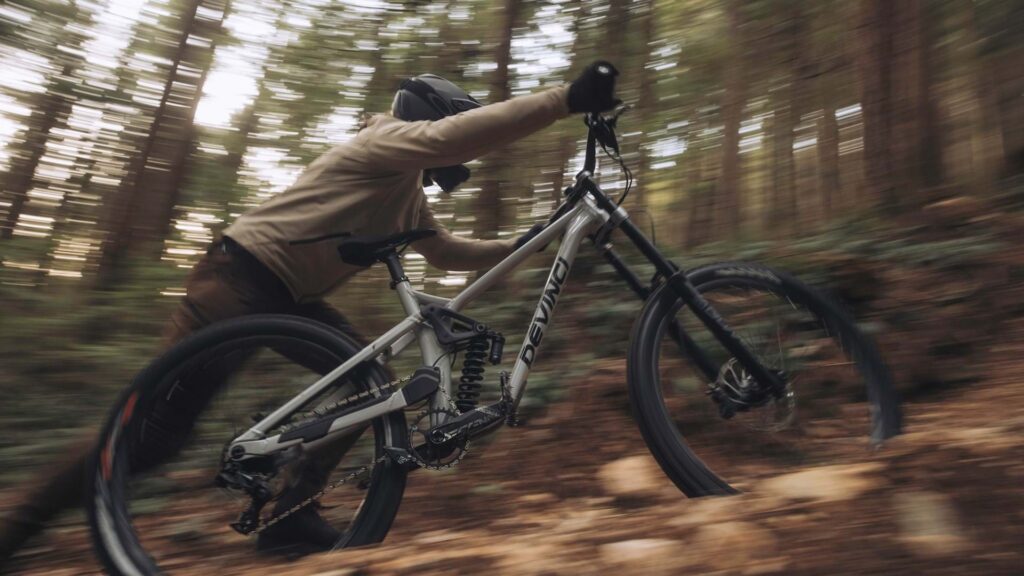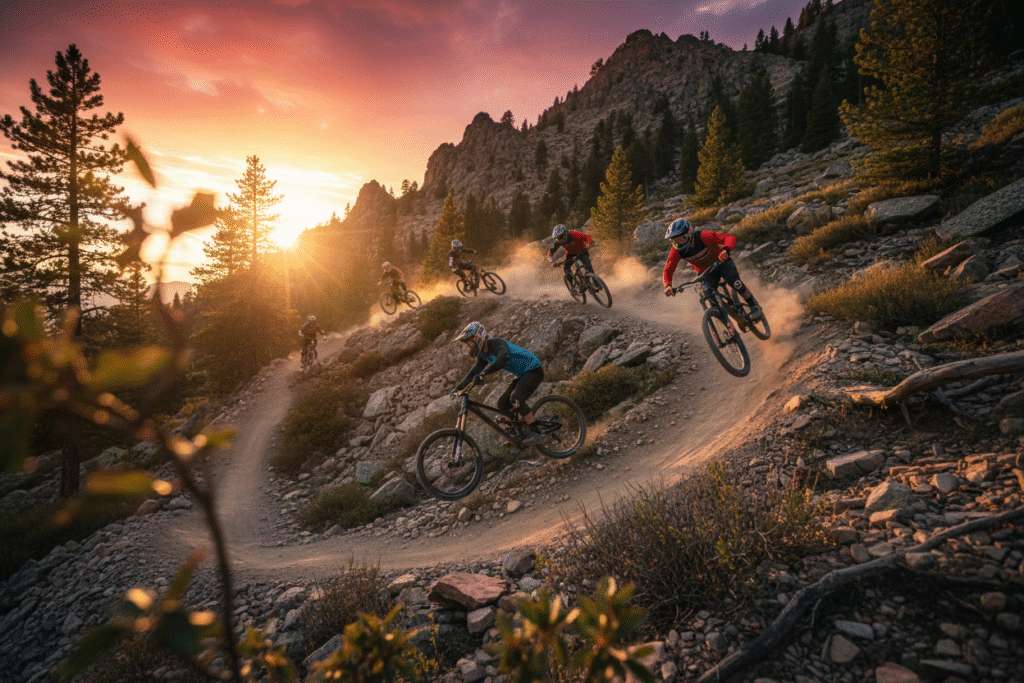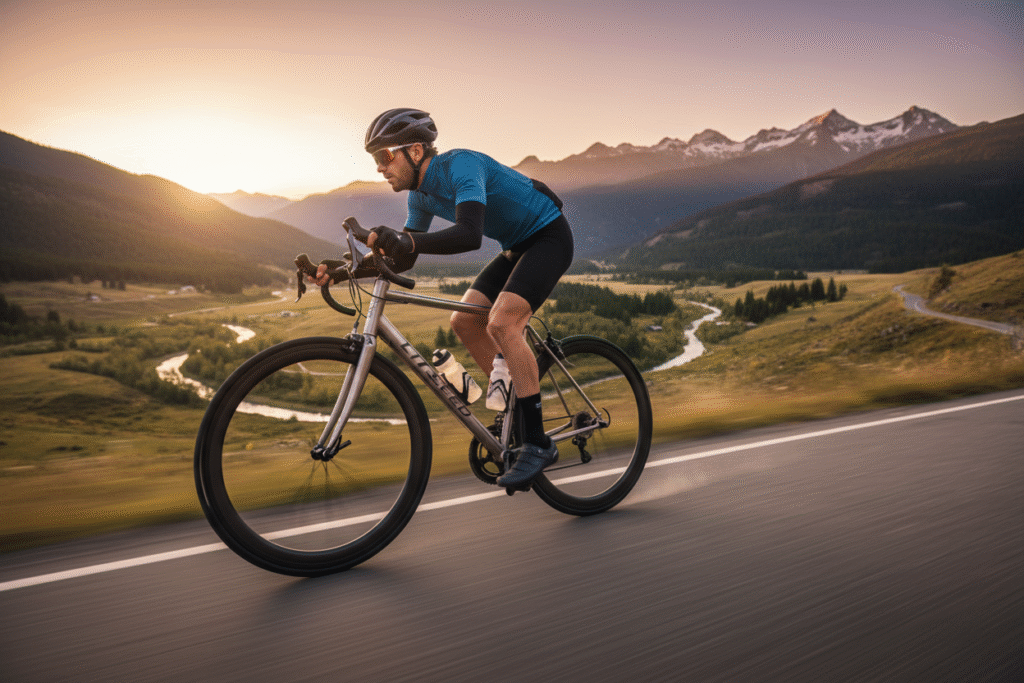Transition Bikes has always been a brand for riders who care more about grins than lap times. Based in Bellingham, Washington, this rider-owned company has grown from a small crew of friends in the early 2000s into one of the most influential boutique mountain bike builders on the planet.
Heading into 2026, Transition is still doing what it does best: mixing modern geometry, sensible suspension design, and a very clear “fun-first” attitude. The result is a lineup of bikes that are as capable as anything on the market, but never feel overly serious or race-obsessed.
What follows is a deep dive into Transition’s story, philosophy, lineup, key technologies, and ride feel—plus how they stack up against other premium MTB brands. If you’re looking at a Spur, Smuggler, Sentinel, Patrol, TR11, Repeater, or Relay and wondering whether the brand matches your style, this will help you figure it out.
The Origin of Transition Bikes
Transition was founded in 2001 by two friends, Kevin Menard and Kyle Young, who were burned out on the corporate, race-driven mentality that dominated the bike world. They weren’t trying to build the lightest, flashiest, or most wind-tunnel-optimized frames. They wanted bikes that made every lap more fun.
Early models like the DirtBag and Preston FR were pure early-2000s freeride energy: overbuilt frames, simple suspension layouts, and geometry meant for jumps, shore lines, and bike park abuse. They were the kind of bikes you didn’t baby.
As mountain biking evolved—from freeride and park riding into all-mountain and enduro—Transition evolved too. What didn’t change was the attitude: rider-owned, no ego, and a constant focus on how bikes actually feel on the trail.
Today, Transition is still run by riders, still based in Bellingham, and still deeply involved in the local riding scene. The brand’s tone is humble and self-aware—more inside joke and trailhead banter than corporate press release.
Brand Philosophy: “Engineered for Smiles”
If you had to sum up Transition in one phrase, “Engineered for Smiles” is pretty close to perfect. Performance absolutely matters—but only if the bike makes you want to take another lap.
Core Ideas Behind Every Transition
Intuitive geometry
Transition was one of the early drivers behind modern long-reach, slack head angle, steep-seat-tube geometry. Their Speed Balanced Geometry (SBG) system balances a longer front center with shorter fork offsets and steeper seat angles so bikes feel:
- Stable at speed
- Confident on steep terrain
- Still nimble and easy to lean into turns
Suspension that just works
Most of the full-suspension line runs a Horst-link variant called GiddyUp. It’s designed to:
- Pedal efficiently without needing the lockout all the time
- Stay active over roots and chatter
- Ramp up enough to handle big hits without harsh bottom-outs
- Keep braking behavior predictable and controlled
It’s not flashy or overcomplicated—it just feels good under a wide range of riders and terrain.
Playful over clinical
Transition bikes are meant to be popped, drifted, manualed, and generally messed around on. Even the big enduro bikes have a bit of “let’s party” built into the layout.
Community at the center
Transition invests heavily in local trail building and advocacy in Bellingham and beyond. That trail culture is baked into the brand—they’re building bikes for the same type of riders they ride with every day.
If you take your riding seriously but don’t take yourself too seriously, the whole Transition ethos tends to click.
Transition’s 2026 Lineup Overview
Transition’s range covers pretty much every modern mountain category—from short-travel down-country to full DH, plus a growing e-MTB family. Here’s a simplified snapshot of the 2026 lineup:
Trail & All-Mountain
- Spur
- Travel: 120mm rear / 120mm fork
- Wheels: 29″
- Personality: Super-light, fast, and way more capable on descents than the numbers suggest. Great for riders who pedal a lot but still want a playful trail feel.
- Smuggler
- Travel: 130mm rear / 140mm fork
- Wheels: 29″
- Personality: The classic “one bike” sweet spot—efficient on long days, but fun enough to take to more technical trails and light bike-park laps.
Enduro & Big Mountain
- Sentinel
- Travel: 150mm rear / 160mm fork
- Wheels: 29″
- Personality: Big mountain all-rounder. Slack, stable, and confidence-inspiring when things get rough, but still climbs well for its travel.
- Patrol
- Travel: Around 160mm rear / 170mm fork
- Wheels: MX (29″ front / 27.5″ rear)
- Personality: Freeride-friendly enduro bike—loves steep, tech, jumps, and park riding. MX wheel setup keeps it playful and easy to move around.
Downhill
- TR11
- Travel: ~200mm
- Wheels: 29″ or MX depending on build
- Personality: World-Cup-capable DH platform that still feels fun in the bike park, not just a race sled.
E-MTB
- Repeater
- Style: Full-power e-enduro
- Motor/Battery: Shimano EP-series with big-capacity battery
- Use Case: Big climbs, big descents, full-day missions.
- Relay
- Style: Lightweight e-MTB
- Motor: Fazua Ride 60 with removable battery
- Use Case: Feels close to a regular trail/enduro bike on the way down, with just enough assist for big vertical or longer rides.
Despite the differences in travel and intent, they all share the same core traits: modern geometry, a GiddyUp suspension feel, and that easygoing, playful character.
Engineering & Design
Transition’s approach to engineering is very practical. They don’t chase wild linkage systems or proprietary standards just for marketing. Instead, they lean into proven concepts and refine them.
GiddyUp Suspension
GiddyUp is Transition’s Horst-link platform, used across most full-suspension bikes.
Key traits:
- Efficient pedaling:
Enough anti-squat to pedal well in open mode for most situations. - Small-bump sensitivity:
Good traction and comfort over roots and chatter. - Progressive feel:
The leverage curve ramps up toward the end of travel, making it harder to harshly bottom out. - Predictable braking:
Neutral feel under braking helps maintain grip and control.
It’s designed to be easy to live with—set sag, dial in rebound, maybe tweak volume spacers, and ride. No black magic required.
Speed Balanced Geometry (SBG)
SBG was Transition’s answer to the “longer, slacker, faster” trend when things started getting a bit weird. The core idea:
- Use a slacker head angle for high-speed stability and steep-terrain confidence.
- Pair it with a reduced fork offset so the front wheel doesn’t feel like it’s wandering.
- Add a steeper seat tube so you’re centered over the bike while climbing.
The end result: bikes that handle fast, steep, and chunky terrain without feeling like a barge in the corners.
Frame Details
Across both carbon and aluminum frames, Transition tends to include rider-friendly details:
- Threaded bottom brackets
- Sealed cartridge bearings with extra protection
- Clean internal cable routing with access ports
- UDH (Universal Derailleur Hanger) compatibility
- Sensible hardware sizes and easy-to-source bearings
- On newer carbon frames, in-frame storage options
The overall feel is “built to be ridden hard and maintained at home or at a local shop without drama.”
Ride Quality & Performance
Ask people why they like Transition and you hear the same themes over and over.
1. Playfulness
Transition bikes just love to be ridden actively. The combination of low bottom brackets, supportive mid-stroke suspension, and centered geometry makes it easy to:
- Manual over rollers
- Pop off small trail features
- Change lines mid-trail
- Pump terrain instead of just plowing through
Even the big bikes (Sentinel, Patrol) have that “let’s mess around” feel.
2. Stability When it Counts
At speed, the longer front center and SBG front-end design really pay off. You get:
- Confidence on steep chutes
- Stability in rock gardens and high-speed sections
- A front wheel that stays planted rather than tucking
They encourage you to push a little harder without feeling like the bike is going to punish you for it.
3. Pedaling and All-Day Comfort
Transition doesn’t build XC race bikes, but their shorter-travel models like the Spur and Smuggler are surprisingly efficient:
- They pedal well in open mode.
- Climbing position is comfortable thanks to steep seat angles.
- On big backcountry rides, the suspension feel and body position help reduce fatigue.
The longer-travel bikes still climb better than their numbers might suggest, especially if you keep up on suspension setup.
4. Versatility
Flip chips, MX options, coil and air shock compatibility, and sensible spec choices mean you can tune a Transition toward:
- More all-day trail focus, or
- More park and big-mountain focus
without needing to change bikes.
Build Kits & Value
Transition’s builds usually fall into a few tiers (names change but philosophy stays similar):
- Alloy builds:
Lower price points, but still with solid drivetrains and brakes. - Carbon GX / equivalent:
Mid-to-high range—a sweet spot for a lot of riders. - Carbon XO / AXS builds:
Top-shelf, minimal compromises, highest pricing.
Frame-only options are common across the lineup, which appeals to riders who like to customize from the ground up.
Price range (roughly):
- Alloy completes: from around mid-$3K
- Carbon completes: up through the $7K–$10K zone depending on build
- Frame only: varies by model, typically in line with other boutique brands
You’re not buying “budget” here, but when you compare spec, frame details, and ride feel to similarly priced Santa Cruz, Yeti, or Pivot builds, Transition often comes out looking like solid value in the boutique category.
Transition E-Bikes
Transition took its time getting into e-MTBs, and it shows—their electric models ride like Transition first, e-bike second.
Repeater
- Full-power enduro e-MTB
- Built around a Shimano EP-series motor and high-capacity battery
- Geometry and suspension tuned for big days in the mountains
Feels like a powered Sentinel: strong on steep, rough descents, with a chilled, confident demeanor.
Relay
- Lightweight e-MTB
- Fazua Ride 60 motor with a removable battery
- Can be ridden with or without the battery installed
The Relay is for riders who want a “regular bike” feel that just happens to offer assist on the climbs. Descending, it behaves much like Transition’s analog long-travel bikes—lively, quiet, and easy to throw around.
Transition’s Customer Experience
One of Transition’s biggest strengths lives off the trail: how they treat their riders.
Common feedback from owners:
- Support emails answered by actual riders, not scripts
- Warranty issues handled quickly and with minimal friction
- Frame hardware and small parts easy to get, even for older models
- Tech support that’s happy to talk setup and tuning, not just sell you something
Buying a Transition usually feels more like joining a community than interacting with a random brand.
Brand Perception & Rider Community
Transition has built a strong “core rider” reputation:
- Their marketing is funny, self-aware, and grounded in real riding.
- They sponsor riders and events that match their fun-first DNA.
- They’re heavily involved in the Bellingham riding scene—trail work, local events, and community projects.
If you show up to a trailhead on a Transition, it tends to spark conversations with other riders. It’s that kind of brand.
Pros & Cons Summary
What Transition Does Really Well
- Ride feel: Playful, confident, and intuitive across the lineup
- Geometry: SBG is dialed for modern trail and enduro riding
- Suspension: GiddyUp is easy to set up and works in the real world
- Build and details: Thoughtful frame features, good spec choices
- Brand culture: Rider-owned, approachable, and community-minded
- E-MTBs: Repeater and Relay feel like real Transition bikes, not afterthoughts
Where the Tradeoffs Are
- Price: Carbon models sit in the same premium bracket as other boutique brands
- Weight: Not always the absolute lightest option in a given category
- Availability: Smaller production runs can mean limited stock or wait times
- Dealer network: Depending on where you live, you may need to buy direct or travel to a dealer
- Paint durability: Some owners recommend frame protection film if you’re picky about cosmetics
Competitors & Alternatives
Here’s how Transition compares to a few common alternatives:
- Ibis:
Similar boutique, rider-loved vibe but a bit more focused on low weight and pedaling efficiency. Transition leans slightly more gravity and “party-lap” oriented. - Santa Cruz:
Bigger dealer presence, very polished branding, and excellent suspension feel. Transition feels more laid-back and often slightly better value at similar spec. - Yeti:
Race-inspired, premium pricing, and distinctive suspension kinematics. Yeti is more “race and prestige”; Transition is more “let’s go ride and have fun.” - Norco / Trek:
Larger brands with deeper catalogs and more entry-level options. Transition offers fewer models but with a clearer, more focused personality.
Big Picture: Is a Transition the Right Bike for You?
Transition Bikes has carved out a very specific identity in the modern MTB world: high-end, rider-owned, and unapologetically focused on fun. The geometry is modern, the suspension is well thought out, and the bikes hold up to serious riding without feeling like they’re built only for pros or racers.
You’ll probably click with Transition if:
- You care as much about having fun on the trail as you do about going fast.
- You like bikes that feel playful but still handle real enduro and big-mountain terrain.
- You appreciate rider-owned brands that invest in trails and community.
- You want a bike you can ride hard for years and still be stoked on.
You might look elsewhere if:
- You’re chasing the absolute lightest XC race bike.
- You want ultra-budget pricing.
- You prefer a more conservative, ultra-relaxed geometry.
For riders who live for good trails, good friends, and bikes that make every descent more fun, Transition is very easy to recommend in 2026.
Related Content:
- Best E-Bike Brands
- Best Mountain Bike Brands
- Ibis vs Transition
- Yeti Cycles Review
- Rocky Mountain Bikes Review
Why Trust This Review?
BestBikeBrands is built by lifelong cyclists with decades of real-world experience — in the shop, on the trail, and behind the wrench. Our goal is simple: to help riders choose the best bikes and gear with confidence, backed by expert insights and hands-on testing. Learn more about us →






